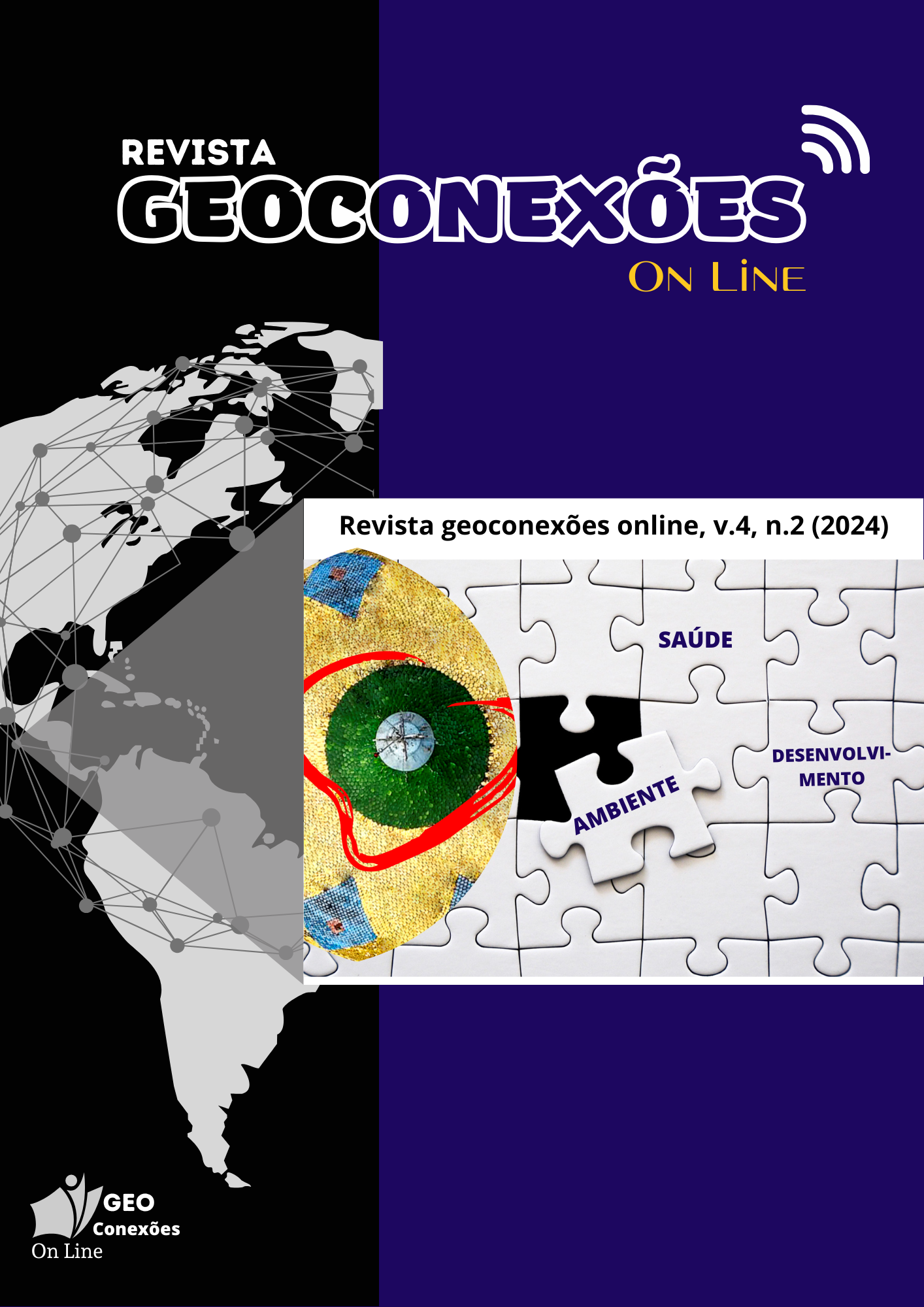AIR QUALITY IN THE CITY OF MANAUS: PARTICULATE MATTER AND ITS RELATIONSHIP WITH WILDFIRES
DOI:
https://doi.org/10.53528/geoconexes.v4i2.155Keywords:
Particulate matter, wildfires, AmazonAbstract
The Amazon has been facing forest fires resulting in emissions of pollutants into the atmosphere, impacting air quality and human health. Manaus stands out as a crucial area of study to assess the influence of these fires on air quality. Brazilian regulations recommend a maximum threshold of 25 µg/m³ (in 24 hours) for Fine Particulate Matter (PM2.5) to categorize air as of good quality. Thus, this study aimed to investigate the temporal variability of PM2.5 in the atmosphere of Manaus from 2003 to 2021, to determine if the air pollution levels were within the recommended limits. Data were evaluated using box plot analyses, considering the entire study period as a reference, to assess two periods of social distancing aimed at combating COVID-19. The results indicate that PM2.5 demonstrates a well-defined annual cycle, with concentrations lower than 25 µg/m³ during the rainy season. In the dry season, PM2.5 concentrations exceed the recommended maximum. During periods of social isolation, there was an observed decrease in the average monthly concentration, likely associated with reduced industrial activities and decreased urban mobility.
References
DE OLIVEIRA ALVES, Nilmara et al. Biomass burning in the Amazon region: Aerosol source apportionment and associated health risk assessment. Atmospheric Environment, v. 120, p. 277-285, 2015. https://doi.org/10.1016/j.atmosenv.2015.08.059
ANDERSON, Liana Oighenstein et al. Vulnerability of Amazonian forests to repeated droughts. Philosophical Transactions of the Royal Society B: Biological Sciences, v. 373, n. 1760, p. 20170411, 2018. https://doi.org/10.1098/rstb.2017.0411
ANDREAE, M. O. et al. Carbon monoxide and related trace gases and aerosols over the Amazon Basin during the wet and dry seasons. Atmospheric Chemistry and Physics, v. 12, n. 13, p. 6041-6065, 2012.https://doi.org/10.5194/acp-12-6041-2012
ANDREAE, Meinrat O. et al. Smoking rain clouds over the Amazon. Science, v. 303, n. 5662, p. 1337-1342, 2004.https://doi.org/10.1126/science.1092779
ARAGÃO, Luiz EOC et al. 21st Century drought-related fires counteract the decline of Amazon deforestation carbon emissions. Nature Communications, v. 9, n. 1, p. 536, 2018. https://doi.org/10.1038/s41467-017-02771-y
ARBEX, Marcos Abdo et al. Queima de biomassa e efeitos sobre a saúde. Jornal Brasileiro de Pneumologia, v. 30, p. 158-175, 2004. https://doi.org/10.1590/S1806-37132004000200015
ARTAXO, Paulo et al. Química atmosférica na Amazônia: a floresta e as emissões de queimadas controlando a composição da atmosfera amazônica. Acta Amazônica, v. 35, p. 185-196, 2005. https://doi.org/10.1590/S0044-59672005000200008
BATISTA, Antonio Carlos. Detecção de incêndios florestais por satélites. Floresta, v. 34, n. 2, 2004. https://doi.org/10.5380/rf.v34i2.2402
BRANDO, Paulo Monteiro et al. Abrupt increases in Amazonian tree mortality due to drought-fire interactions. Proceedings of the National Academy of Sciences, v. 111, n. 17, p. 6347-6352, 2014. https://doi.org/10.1073/pnas.1305499111
BROWN, I. Foster et al. Monitoring fires in southwestern Amazonia rain forests. EOS, Transactions American Geophysical Union, v. 87, n. 26, p. 253-259, 2006. https://doi.org/10.1029/2006EO260001
CARMO, Cleber Nascimento do et al. Associação entre material particulado de queimadas e doenças respiratórias na região sul da Amazônia brasileira. Revista Panamericana de Salud Pública, v. 27, n. 1, p. 10-16, 2010. https://doi.org/10.1590/S1020-49892010000100002
DE OLIVEIRA ALVES, Nilmara et al. Biomass burning in the Amazon region causes DNA damage and cell death in human lung cells. Scientific reports, v. 7, n. 1, p. 10937, 2017. https://doi.org/10.1038/s41598-017-11024-3
ESKES, H. J. et al. Upgrade verification note for the CAMS real-time global atmospheric composition service: Evaluation of the e-suite for the CAMS 47R1 upgrade of October 2020. 2021.
GRANEMANN, Daniel Carvalho; CARNEIRO, Gerson Luiz. Monitoramento de focos de incêndio e áreas queimadas com a utilização de imagens de sensoriamento remoto. Revista de engenharia e tecnologia, v. 1, n. 1, p. Páginas 55-62, 2009.
IGNOTTI, Eliane et al. Impactos na saúde humana de partículas emitidas por queimadas na Amazônia brasileira. Revista de Saúde Pública, v. 44, n. 1, p. 121-130, 2010.
JOLLY, W. Matt et al. Climate-induced variations in global wildfire danger from 1979 to 2013. Nature Communications, v. 6, n. 1, p. 7537, 2015. https://doi.org/10.1038/ncomms8537
LIU, Zifei et al. Health and environmental impacts of smoke from vegetation fires: A review. Journal of Environmental Protection, v. 7, p. 1860-1885, 2016. https://doi.org/10.4236/jep.2016.712148
LONGO, Karla Maria et al. Biomass burning in Amazonia: Emissions, long-range transport of smoke and its regional and remote impacts. Washington DC American Geophysical Union Geophysical Monograph Series, v. 186, p. 207-232, 2009. https://doi.org/10.1029/2008GM000847
MARENGO, Jose A. et al. The drought of 2010 in the context of historical droughts in the Amazon region. Geophysical Research Letters, v. 38, n. 12, 2011. https://doi.org/10.1029/2011GL047436
MORISETTE, Jeffrey T. et al. Validation of MODIS active fire detection products derived from two algorithms. Earth Interactions, v. 9, n. 9, p. 1-25, 2005. https://doi.org/10.1175/EI141.1
PANISSET, Jéssica S. et al. Contrasting patterns of the extreme drought episodes of 2005, 2010 and 2015 in the Amazon Basin. International Journal of Climatology, v. 38, n. 2, p. 1096-1104, 2018. https://doi.org/10.1002/joc.5224
REDDINGTON, C. L. et al. Air quality and human health improvements from reductions in deforestation-related fire in Brazil. Nature Geoscience, v. 8, n. 10, p. 768-771, 2015. https://doi.org/10.1038/ngeo2535
RIBEIRO, Igor Oliveira et al. Biomass burning and carbon monoxide patterns in Brazil during the extreme drought years of 2005, 2010, and 2015. Environmental Pollution, v. 243, p. 1008-1014, 2018. https://doi.org/10.1016/j.envpol.2018.09.022
SILVA, Sonaira Souza et al. Dynamics of forest fires in the southwestern Amazon. Forest Ecology and Management, v. 424, p. 312-322, 2018. https://doi.org/10.1016/j.foreco.2018.04.041
Downloads
Published
How to Cite
Issue
Section
Categories
License
Copyright (c) 2024 Bruna Oliveira; Rodrigo Souza, Rita Andreoli

This work is licensed under a Creative Commons Attribution-ShareAlike 4.0 International License.
A revista se reserva o direito de efetuar, nos originais, alterações de ordem normativa, ortográfica e gramatical, com vistas a manter o padrão culto da língua e a credibilidade do veículo. Respeitará, no entanto, o estilo de escrever dos autores. Alterações, correções ou sugestões de ordem conceitual serão encaminhadas aos autores, quando necessário.
<a rel="license" href="http://creativecommons.org/licenses/by-nc/4.0/"><img alt="Creative Commons License" style="border-width:0" src="https://i.creativecommons.org/l/by-nc/4.0/88x31.png" /></a><br />This work is licensed under a <a rel="license" href="http://creativecommons.org/licenses/by-nc/4.0/">Creative Commons Attribution-NonCommercial 4.0 International License</a>.











